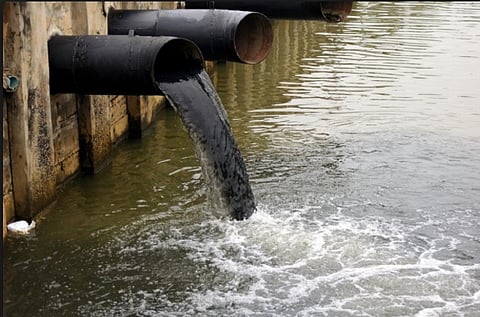
- Home
- Live Blog
- Breaking News
- Top Headlines
- Cities
- NE News
- Sentinel Media
- Sports
- Education
- Jobs

Roshna N.
(Roshna N. is a Research Engineer at Bengaluru’s Center for Study of Science, Technology and Policy [CSTEP], a research-policy think tank. The views expressed are those of CSTEP. The author may be contacted at roshana@cstep.in)
The United Nations Environment Programme (UNEP) has reported that India is on the verge of becoming a highly water-stressed country. At this stage, reducing wastewater generation and water recycling should be given due importance. Reuse of industrial wastewater has been in practice for a long time in India, and this water is mainly used for agriculture purposes in nearby areas. However, this has led to high levels of heavy metal concentration in vegetables grown with industrial wastewater.
India generates around 13,500 million litres of industrial wastewater every day, an alarming amount of which is discharged into natural water sources without proper treatment, owing to the high costs involved.
This unprocessed sludge contains large amounts of heavy metals, which can pose a serious health hazard to people. These metals can enter the human body via water, air and food - or even absorption through the skin - and accumulate in the tissues, leading to skin cancer, bone defects, mental retardation in children and chronic damage to the nervous system et al.
A study conducted by the Ministry of Water Resources analysed the amount of heavy metals in Indian rivers from 2014 to 2017. High concentrations of these metals, exceeding the permissible limits for drinking water, were observed in big rivers such as the Ganga, Rapti, Ramganga, Subarnarekha, and Tungabhadra.
Observing the standards for heavy metals in these rivers is essential, as nearly 80 per cent of the rural population and 50 per cent of the urban population depend on surface and groundwater for domestic purposes. However, no rigorous action has been taken in this regard.
Concentration of heavy metals such as lead, cadmium, and chromium in edible fish tissues in Indian rivers is around 1.4-17 µg/g of dry weight (permissible limit - 0.5 µg/g), 0.62-34 µg/g (permissible limit - 0.5 µg/g), and 0.75-18 µg/g (permissible limit - 2 µg/g) respectively.
Techniques For Removing Heavy Metals
There are physical, chemical, and biological methods to remove heavy metals from industrial wastewater.
Physical methods include membrane separation, adsorption, screening and gravity concentration.
Chemical methods such as chemical precipitation use chemical reagents to increase the particle size of the colloidal suspension and the heavy metals are then removed via a filtration process. Some of the biological techniques such as activated sludge process and trickling filters use microorganisms for removal treatments.
Among the treatment techniques, adsorption (a substance that aborbs another) is the most effective and eco-friendly. In this process, heavy metals in water adhere to the surface of an adsorbent via physical or chemical interaction. Adsorption occurs only at the surface of the material (adsorbent). The most common adsorbent used in industries is activated carbon, for removing heavy metals, toxic gases, and other elements. Even though it is widely used for many industrial activities, its high cost (Rs 30,000-60,000/tonnes) is a drawback.
Organic Waste as Heavy Metal Adsorbents
In recent years, various studies have been carried out to develop safe and cost-effective adsorbents. Research shows that organic waste can be used as an adsorbent. Such bio-adsorbents consist of different functional groups, such as hydroxyls and amines that have a great affinity for metal ions. In India, around 150 million tonnes of agricultural waste is generated annually. Using organic waste as bio-adsorbents could help agro-industries and farmers manage their waste efficiently, and generate additional revenue.
The adsorptive power of many organic wastes such as waste tea leaves, rice husk, banana peel, coconut palm leaves, sugarcane bagasse, and mango peel was investigated. Such bio-adsorbents, without any modifications, have lower adsorbent capabilities. Modified bio-adsorbents with higher metal adsorption capacity were made via chemical treatment. Charred banana peel, charred xanthated sugarcane bagasse, charred orange peel, and charred chlorinated tea leaves are some of the modified low-cost adsorbents. A modified adsorbent is a cost-effective alternative for activated carbon. In fact, a few of them have better adsorptive power than activated carbon.
Adsorbed heavy metals can then be recovered via acid or base treatment, and the bio-adsorbents can then be reused. This will create additional income for industries.
The Way Forward
Deployment of cost-effective technologies for water treatment (such as bio-adsorbents) will have significant traction in the upcoming years as there are growing concerns about the quality of recycled water. However, adoption of bio-adsorbents in Indian industries is not even in the primitive stage. As an initial step, setting up a bio-adsorbent ‘pilot plant’ in existing common effluent treatment plants (CETPs) is an economically viable option. CETPs can opt for existing financial assistance schemes from central and state pollution control boards and state governments for technology upgrades.
The collection and supply of bio-adsorbents also need proper management. Suitable agro-waste collection mechanisms should be developed by the Ministry of Agriculture. These could help in generating additional revenue for farmers and also reduce smoke and haze resulting from agro-waste burning. Therefore, with collaborative efforts from industries, pollution control boards, agro-producers, and water supply departments, recycling and management of toxic industrial wastewater can be carried out in an economical way. (IANS)